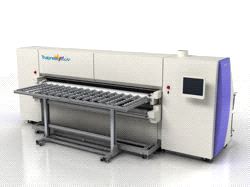LFP - Large-Format-Printing
Willamette Print & Blueprint Sees Unlimited Potential in Screen Truepress Jet2500UV

Wednesday 02. October 2013 - Some companies are better at weathering economic storms than others. They aren't necessarily bigger, better known or more generously capitalized. What separates enterprises that thrive no matter what the business climate from those that succumb to recessionary cycles is the successful companies have contingencies in place to confront any challenges that might arise.
Even companies tied to hard-hit industries like construction can diversify for success. Willamette Print & Blueprint (WP&B) is a case in point.
WP&B, a $5 million reprographics firm in Portland, Ore., has been diversifying for decades. Its dynamic approach to planning resulted in the adoption of the Screen Truepress Jet2500UV board and roll inkjet printing system.
“Our company has survived a number of recessions over the years by taking advantage of opportunities that constantly present themselves,” said Neil Humphrey, president. “Diversification has made us less vulnerable to the building industry’s ups and downs.”
Founded in 1975, WP&B serves Oregon and southwest Washington’s architectural, engineering and construction community. A member of the ReproMAX network, WP&B delivers high-quality color imaging and finishing services utilizing toner-based, latex and inkjet printers. The company also offers a complete range of mounting and laminating options.
Although WP&B had developed a strong large-format portfolio, including posters, signage, banners and point-of-purchase displays, its previous technology lineup didn’t allow for printing directly onto rigid substrates.
“Printing on adhesive vinyl that has to be applied to different media takes longer, costs more and limits the creative possibilities,” said David Guzman, vice president. “We needed to go to the next step in wide-format color products to stand out from the ‘me too’ printers.”
When it was time to upgrade to its first large-format direct-to-substrate printer, WP&B researched printing systems that could ensure extremely high quality on flexible and rigid substrates, such as corrugated fiberboard, aluminum composite material and acrylic sheets.
“We conducted an exhaustive comparison of printing systems,” Humphrey said. “The Truepress Jet2500UV’s unique capabilities eliminated competing technologies from consideration. The types of media it handles and output it can achieve are very diverse. We pride ourselves on producing very high-quality color printing, and we wanted that to carry over to all substrates. The image reproduction on the Truepress is definitely superior to anything we saw on other machines.”
The Truepress Jet2500UV accommodates roll-fed paper, vinyl film, banners and textiles, as well as glass, ceramic tile, plywood and aluminum, up to 1.96 inches thick and 98.4 inches wide. It supports a maximum output resolution of 1,500 dpi. For a complete print-to-cut solution, WP&B paired the Truepress Jet2500UV with a Zünd G3 cutter/router.
“The Truepress really augments our capabilities,” Guzman said. “Although there is some overlap with the latex equipment, our other digital printers serve different market needs.”
WP&B installed the Truepress Jet2500UV in August 2013, and it already has unlocked new revenue streams.
“We’ve done projects that never came up on my radar screen before,” Humphrey noted. “A customer asked us to print on textured, rubber yoga mats to give away as promotional items. The Truepress Jet2500UV allows us to print short-run specialty jobs cost-effectively. It prints full-bleed images on uneven, embossed or difficult substrates. The flexible ink withstands bending or folding.”
One feature that gives WP&B remarkable application versatility is its ability to print up to seven image layers, including images in opaque white ink, at one time. It is possible to overprint images multiple times in one pass with highly accurate registration.
“The ability to do 21-layer dimensional printing was an important consideration for us,” Humphrey said. “The increased ink thickness produces a 3D structure and feel. That creates business avenues for printing restaurant installations and museum displays. Really, the applications are unlimited. We feel we can become as well known for our color imaging as we are in the building industry.”
